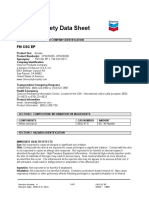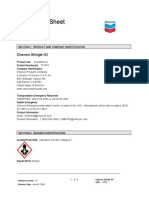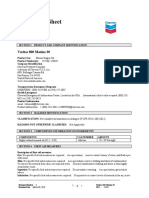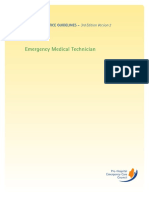Chevron Saw 30 RPM
Chevron Saw 30 RPM
Uploaded by
Om Prakash RajCopyright:
Available Formats
Chevron Saw 30 RPM
Chevron Saw 30 RPM
Uploaded by
Om Prakash RajOriginal Title
Copyright
Available Formats
Share this document
Did you find this document useful?
Is this content inappropriate?
Copyright:
Available Formats
Chevron Saw 30 RPM
Chevron Saw 30 RPM
Uploaded by
Om Prakash RajCopyright:
Available Formats
Material Safety Data Sheet
SECTION 1 PRODUCT AND COMPANY IDENTIFICATION
Chevron RPM® Synthetic Transmission Fluid SAE 50
Product Number(s): CPS210456
Company Identification
Productos Chevron México, S. de R.L. De C.V.
Oriente 171 Núm 401
Col.San Juan Aragon Amplición
Delegacion Gustavo A. Madero C.P. 07470
Mexico
Transportation Emergency Response
CHEMTREC: (800) 424-9300 or (703) 527-3887
Mexico - SETIQ: 01 800 00 214 00 y 55 59 15 88 (D.F.)
Health Emergency
Chevron Emergency Information Center: Located in the USA. International collect calls accepted. (800)
231-0623 or (510) 231-0623
Product Information
email : ordenesmexico@chevron.com
MSDS Requests: 01 (800) 711-8772
SECTION 2 COMPOSITION/ INFORMATION ON INGREDIENTS
COMPONENTS CAS NUMBER AMOUNT
Synthetic hydrocarbons Mixture 75 - 100 %weight
Zinc dialkyldithiophosphate 68649-42-3 1 - 5 %weight
SECTION 3 HAZARDS IDENTIFICATION
IMMEDIATE HEALTH EFFECTS
Eye: Not expected to cause prolonged or significant eye irritation.
Skin: Contact with the skin is not expected to cause prolonged or significant irritation. Not expected to be
harmful to internal organs if absorbed through the skin.
Ingestion: Not expected to be harmful if swallowed.
Inhalation: Not expected to be harmful if inhaled. Contains a synthetic hydrocarbon oil. May cause
respiratory irritation or other pulmonary effects following prolonged or repeated inhalation of oil mist at
airborne levels above the recommended mineral oil mist exposure limit. Symptoms of respiratory irritation
may include coughing and difficulty breathing.
SECTION 4 FIRST AID MEASURES
Eye: No specific first aid measures are required. As a precaution, remove contact lenses, if worn, and
flush eyes with water.
_____________________________________________________________________
Revision Number: 10 1 of 6 Chevron RPM® Synthetic
Revision Date: 03/16/2004 Transmission Fluid SAE 50
MSDS : 4896MEX
Skin: No specific first aid measures are required. As a precaution, remove clothing and shoes if
contaminated. To remove the material from skin, use soap and water. Discard contaminated clothing and
shoes or thoroughly clean before reuse.
Ingestion: No specific first aid measures are required. Do not induce vomiting. As a precaution, get
medical advice.
Inhalation: No specific first aid measures are required. If exposed to excessive levels of material in the air,
move the exposed person to fresh air. Get medical attention if coughing or respiratory discomfort occurs.
SECTION 5 FIRE FIGHTING MEASURES
FLAMMABLE PROPERTIES:
Flashpoint: (Cleveland Open Cup) 228 °C (442 °F) (Typical)
Autoignition: No Data Available
Flammability (Explosive) Limits (% by volume in air): Lower: Not Applicable Upper: Not
Applicable
EXTINGUISHING MEDIA: Use water fog, foam, dry chemical or carbon dioxide (CO2) to extinguish flames.
PROTECTION OF FIRE FIGHTERS:
Fire Fighting Instructions: This material will burn although it is not easily ignited. For fires involving this
material, do not enter any enclosed or confined fire space without proper protective equipment, including
self-contained breathing apparatus.
Combustion Products: Highly dependent on combustion conditions. A complex mixture of airborne
solids, liquids, and gases including carbon monoxide, carbon dioxide, and unidentified organic compounds
will be evolved when this material undergoes combustion. Combustion may form oxides of: Phosphorus,
Sulfur, Zinc .
SECTION 6 ACCIDENTAL RELEASE MEASURES
Protective Measures: Eliminate all sources of ignition in vicinity of spilled material.
Spill Management: Stop the source of the release if you can do it without risk. Contain release to prevent
further contamination of soil, surface water or groundwater. Clean up spill as soon as possible, observing
precautions in Exposure Controls/Personal Protection. Use appropriate techniques such as applying
non-combustible absorbent materials or pumping. Where feasible and appropriate, remove contaminated
soil. Place contaminated materials in disposable containers and dispose of in a manner consistent with
applicable regulations.
Reporting: Report spills to local authorities as appropriate or required.
SECTION 7 HANDLING AND STORAGE
Precautionary Measures: Keep out of the reach of children.
General Handling Information: Avoid contaminating soil or releasing this material into sewage and
drainage systems and bodies of water.
Static Hazard: Electrostatic charge may accumulate and create a hazardous condition when handling this
material. To minimize this hazard, bonding and grounding may be necessary but may not, by themselves,
be sufficient. Review all operations which have the potential of generating and accumulating an electrostatic
charge and/or a flammable atmosphere (including tank and container filling, splash filling, tank cleaning,
sampling, gauging, switch loading, filtering, mixing, agitation, and vacuum truck operations) and use
appropriate mitigating procedures.
Container Warnings: Container is not designed to contain pressure. Do not use pressure to empty
container or it may rupture with explosive force. Empty containers retain product residue (solid, liquid,
and/or vapor) and can be dangerous. Do not pressurize, cut, weld, braze, solder, drill, grind, or expose
_____________________________________________________________________
Revision Number: 10 2 of 6 Chevron RPM® Synthetic
Revision Date: 03/16/2004 Transmission Fluid SAE 50
MSDS : 4896MEX
such containers to heat, flame, sparks, static electricity, or other sources of ignition. They may explode and
cause injury or death. Empty containers should be completely drained, properly closed, and promptly
returned to a drum reconditioner or disposed of properly.
SECTION 8 EXPOSURE CONTROLS/PERSONAL PROTECTION
GENERAL CONSIDERATIONS:
Consider the potential hazards of this material (see Section 3), applicable exposure limits, job activities, and
other substances in the work place when designing engineering controls and selecting personal protective
equipment. If engineering controls or work practices are not adequate to prevent exposure to harmful
levels of this material, the personal protective equipment listed below is recommended. The user should
read and understand all instructions and limitations supplied with the equipment since protection is usually
provided for a limited time or under certain circumstances.
ENGINEERING CONTROLS:
Use in a well-ventilated area.
PERSONAL PROTECTIVE EQUIPMENT
Eye/Face Protection: No special eye protection is normally required. Where splashing is possible, wear
safety glasses with side shields as a good safety practice.
Skin Protection: No special protective clothing is normally required. Where splashing is possible, select
protective clothing depending on operations conducted, physical requirements and other substances in the
workplace. Suggested materials for protective gloves include: 4H (PE/EVAL), Nitrile Rubber, Silver Shield,
Viton.
Respiratory Protection: No respiratory protection is normally required. If user operations generate an oil
mist, determine if airborne concentrations are below the occupational exposure limit for mineral oil mist. If
not, wear an approved respirator that provides adequate protection from the measured concentrations of
this material. For air-purifying respirators use a particulate cartridge.
Use a positive pressure air-supplying respirator in circumstances where air-purifying respirators may not
provide adequate protection.
No applicable occupational exposure limits exist for this material or its components.
SECTION 9 PHYSICAL AND CHEMICAL PROPERTIES
Attention: the data below are typical values and do not constitute a specification.
Color: Amber
Physical State: Liquid
Odor: Faint or Mild
pH: Not Applicable
Vapor Pressure: <0.1 mmHg @ 20 °C (68 °F)
Vapor Density (Air = 1): >2
Boiling Point: >316°C (600.8°F)
Solubility: Soluble in hydrocarbons; insoluble in water
Freezing Point: Not Applicable
Specific Gravity: 0.87 @ 15.6°C (60.1°F) / 15.6°C (60.1°F) (Typical)
Viscosity: 16.5 cSt @ 100°C (212°F) (Min)
SECTION 10 STABILITY AND REACTIVITY
Chemical Stability: This material is considered stable under normal ambient and anticipated storage and
handling conditions of temperature and pressure.
Incompatibility With Other Materials: May react with strong acids or strong oxidizing agents, such as
_____________________________________________________________________
Revision Number: 10 3 of 6 Chevron RPM® Synthetic
Revision Date: 03/16/2004 Transmission Fluid SAE 50
MSDS : 4896MEX
chlorates, nitrates, peroxides, etc.
Hazardous Decomposition Products: Hydrogen Sulfide (Temperatures >149 °F (65 °C))
Hazardous Polymerization: Hazardous polymerization will not occur.
SECTION 11 TOXICOLOGICAL INFORMATION
IMMEDIATE HEALTH EFFECTS
Eye Irritation: The eye irritation hazard is based on evaluation of data for similar materials or product
components.
Skin Irritation: The skin irritation hazard is based on evaluation of data for similar materials or product
components.
Skin Sensitization: No product toxicology data available.
Acute Dermal Toxicity: The acute dermal toxicity hazard is based on evaluation of data for similar
materials or product components.
Acute Oral Toxicity: The acute oral toxicity hazard is based on evaluation of data for similar materials or
product components.
Acute Inhalation Toxicity: The acute inhalation toxicity hazard is based on evaluation of data for similar
materials or product components.
SECTION 12 ECOLOGICAL INFORMATION
ECOTOXICITY
The toxicity of this material to aquatic organisms has not been evaluated. Consequently, this material
should be kept out of sewage and drainage systems and all bodies of water.
ENVIRONMENTAL FATE
This material is not expected to be readily biodegradable.
SECTION 13 DISPOSAL CONSIDERATIONS
Use material for its intended purpose or recycle if possible. Oil collection services are available for used oil
recycling or disposal. Place contaminated materials in containers and dispose of in a manner consistent
with applicable regulations. Contact your sales representative or local environmental or health authorities
for approved disposal or recycling methods.
SECTION 14 TRANSPORT INFORMATION
The description shown may not apply to all shipping situations. Consult 49CFR, or appropriate Dangerous
Goods Regulations, for additional description requirements (e.g., technical name) and mode-specific or
quantity-specific shipping requirements.
DOT Shipping Name: NOT REGULATED AS A HAZARDOUS MATERIAL FOR TRANSPORTATION
UNDER 49 CFR
DOT Hazard Class: NOT APPLICABLE
DOT Identification Number: NOT APPLICABLE
DOT Packing Group: NOT APPLICABLE
Additional Information: NOT HAZARDOUS BY U.S. DOT. ADR/RID HAZARD CLASS NOT
APPLICABLE.
IMO/IMDG Shipping Name: NOT REGULATED AS DANGEROUS GOODS FOR TRANSPORT UNDER
_____________________________________________________________________
Revision Number: 10 4 of 6 Chevron RPM® Synthetic
Revision Date: 03/16/2004 Transmission Fluid SAE 50
MSDS : 4896MEX
THE IMDG CODE
IMO/IMDG Hazard Class: NOT APPLICABLE
IMO/IMDG Identification Number: NOT APPLICABLE
IMO/IMDG Packing Group: NOT APPLICABLE
ICAO/IATA Shipping Name: NOT REGULATED AS DANGEROUS GOODS FOR TRANSPORT UNDER
ICAO
ICAO/IATA Hazard Class: NOT APPLICABLE
ICAO/IATA Identification Number: NOT APPLICABLE
ICAO/IATA Packing Group: NOT APPLICABLE
SECTION 15 REGULATORY INFORMATION
REGULATORY LISTS SEARCHED:
01-1=IARC Group 1
01-2A=IARC Group 2A
01-2B=IARC Group 2B
No components of this material were found on the regulatory lists above.
CHEMICAL INVENTORIES:
AUSTRALIA: All the components of this material are listed on the Australian Inventory of Chemical
Substances (AICS).
EUROPEAN UNION: All the components of this material are in compliance with the EU Seventh
Amendment Directive 92/32/EEC.
UNITED STATES: All of the components of this material are on the Toxic Substances Control Act (TSCA)
Chemical Inventory.
WHMIS CLASSIFICATION:
This product is not considered a controlled product according to the criteria of the Canadian Controlled
Products Regulations.
SECTION 16 OTHER INFORMATION
REVISION STATEMENT: This revision updates the following sections of this Material Safety Data Sheet:
1-16
Revision Date 03/16/2004
ABBREVIATIONS THAT MAY HAVE BEEN USED IN THIS DOCUMENT:
TLV - Threshold Limit Value TWA - Time Weighted Average
STEL - Short-term Exposure Limit PEL - Permissible Exposure Limit
CAS - Chemical Abstract Service Number
ACGIH - American Conference of Government IMO/IMDG - International Maritime Dangerous Goods
Industrial Hygienists Code
API - American Petroleum Institute MSDS - Material Safety Data Sheet
CVX - Chevron NFPA - National Fire Protection Association (USA)
DOT - Department of Transportation (USA) NTP - National Toxicology Program (USA)
IARC - International Agency for Research on OSHA - Occupational Safety and Health Administration
Cancer
Prepared according to the International Standard (ISO 11014-1) by the Chevron Energy Research &
Technology Company, 100 Chevron Way, Richmond, California 94802.
_____________________________________________________________________
Revision Number: 10 5 of 6 Chevron RPM® Synthetic
Revision Date: 03/16/2004 Transmission Fluid SAE 50
MSDS : 4896MEX
The above information is based on the data of which we are aware and is believed to be correct as of the
date hereof. Since this information may be applied under conditions beyond our control and with which we
may be unfamiliar and since data made available subsequent to the date hereof may suggest modifications
of the information, we do not assume any responsibility for the results of its use. This information is
furnished upon condition that the person receiving it shall make his own determination of the suitability of
the material for his particular purpose.
MSDS
_____________________________________________________________________
Revision Number: 10 6 of 6 Chevron RPM® Synthetic
Revision Date: 03/16/2004 Transmission Fluid SAE 50
MSDS : 4896MEX
You might also like
- Asbestos Awareness Quiz #1: AnswersDocument2 pagesAsbestos Awareness Quiz #1: AnswersMichael NcubeNo ratings yet
- Diesel Motor Oil MSDS PDFDocument9 pagesDiesel Motor Oil MSDS PDFMoaatazz NouisriNo ratings yet
- Hydraulicoil Awiso32 MsdsDocument7 pagesHydraulicoil Awiso32 Msdsjino471No ratings yet
- MSDS - Caltex Canopus 32 - ENDocument7 pagesMSDS - Caltex Canopus 32 - ENnghiaNo ratings yet
- Msds Chevron 15w40Document7 pagesMsds Chevron 15w40Luis Sanchez LlicoNo ratings yet
- SDS - CH VARTECH™ Industrial System CleanerDocument8 pagesSDS - CH VARTECH™ Industrial System CleanerGeorgina SuleNo ratings yet
- Multipurpose GreaseDocument6 pagesMultipurpose Greasehaiderparrai00No ratings yet
- Clarity Synthetic GreaseDocument7 pagesClarity Synthetic GreaseOm Prakash RajNo ratings yet
- Material Safety Data Sheet: Meropa® 68, 100, 150, 220, 320, 460, 680, 1000, 1500Document5 pagesMaterial Safety Data Sheet: Meropa® 68, 100, 150, 220, 320, 460, 680, 1000, 1500khurramNo ratings yet
- Lubricant - Chevron Products - Clarity Synthetic Ea Hydraulic Oil 46-68-100Document8 pagesLubricant - Chevron Products - Clarity Synthetic Ea Hydraulic Oil 46-68-100Tharangini MNo ratings yet
- Chevron Ursa SuperPlus EC 15w40 271201 MSDSDocument7 pagesChevron Ursa SuperPlus EC 15w40 271201 MSDSImam Saja DechNo ratings yet
- FICHA DE SEGURIDAD DE DE GRASA SANITARIA FM - CSC - EpDocument6 pagesFICHA DE SEGURIDAD DE DE GRASA SANITARIA FM - CSC - EpControl de Calidad MontefioriNo ratings yet
- Safety Data Sheet: Delo Gold Ultra SAE 15W-40Document6 pagesSafety Data Sheet: Delo Gold Ultra SAE 15W-40Nasta Ina RobayasaNo ratings yet
- Alfamar MsdsDocument6 pagesAlfamar Msdsvangeliskyriakos8998No ratings yet
- Safety Data Sheet: Texclad 2Document7 pagesSafety Data Sheet: Texclad 2KuhnNo ratings yet
- Caltex Hydraulic Oil AW - SDSDocument6 pagesCaltex Hydraulic Oil AW - SDSpatrickhenrieemasNo ratings yet
- Ms Ds Detail PageDocument9 pagesMs Ds Detail PageCarlos GuashcoNo ratings yet
- SDS - Hydraulic 32Document9 pagesSDS - Hydraulic 32Zaw Htet WinNo ratings yet
- MSDS ChevronnDocument9 pagesMSDS ChevronnHasan UğurluNo ratings yet
- Safety Data Sheet: Chevron Ultra-Duty Grease EP NLGI 0, 1, 2Document8 pagesSafety Data Sheet: Chevron Ultra-Duty Grease EP NLGI 0, 1, 2Sofels FemiNo ratings yet
- SDS - Used Lubricating Oil (New) 2019Document7 pagesSDS - Used Lubricating Oil (New) 2019VivekNo ratings yet
- Cetus de 100 UsDocument6 pagesCetus de 100 UsAustin UdofiaNo ratings yet
- Quentrex 2500Document6 pagesQuentrex 2500Om Prakash RajNo ratings yet
- Capella wf32Document7 pagesCapella wf32Om Prakash RajNo ratings yet
- MSDS - Texamatic 1888Document6 pagesMSDS - Texamatic 1888Jon HermanNo ratings yet
- Taro 20 Taro 30 DP 30Document6 pagesTaro 20 Taro 30 DP 30Om Prakash RajNo ratings yet
- Multifak Ep 2 EuDocument6 pagesMultifak Ep 2 EuRaul MezaNo ratings yet
- Safety Data Sheet: Used Lubricating Oil (For Laboratory Testing Purposes)Document6 pagesSafety Data Sheet: Used Lubricating Oil (For Laboratory Testing Purposes)Om Prakash RajNo ratings yet
- MSDS - GreaseDocument8 pagesMSDS - GreaseDimitrios KolovosNo ratings yet
- Safety Data Sheet: Chevron (Singapore) Diesel Gas OilDocument8 pagesSafety Data Sheet: Chevron (Singapore) Diesel Gas OilMaza LufiasNo ratings yet
- Safety Data Sheet: Chevron (Singapore) Diesel Gas OilDocument8 pagesSafety Data Sheet: Chevron (Singapore) Diesel Gas OilWalter NativoNo ratings yet
- SDSDetail PageDocument7 pagesSDSDetail PagekaranNo ratings yet
- Caltex Delo-Syn-ATF-HD-SDS-37313-1-July-2015Document7 pagesCaltex Delo-Syn-ATF-HD-SDS-37313-1-July-2015AlMarzouk ShivaNo ratings yet
- Safety Data Sheet: Rando HDZ 46Document6 pagesSafety Data Sheet: Rando HDZ 46Om Prakash RajNo ratings yet
- Safety Data Sheet: Texclad 2Document7 pagesSafety Data Sheet: Texclad 2Om Prakash RajNo ratings yet
- Chevron Lubricant SDSDocument9 pagesChevron Lubricant SDSSofels FemiNo ratings yet
- Chevron Supreme Motor Oil SAE 30Document7 pagesChevron Supreme Motor Oil SAE 30sofelsbabaNo ratings yet
- Safety Data Sheet: Ursa Super Plus EC SAE 15W-40Document6 pagesSafety Data Sheet: Ursa Super Plus EC SAE 15W-40Om Prakash RajNo ratings yet
- Cat NGEC Natural Gas Engine CoolantDocument8 pagesCat NGEC Natural Gas Engine CoolantGary MosesNo ratings yet
- Cat Elc (Extended Life Coolant) MdsDocument8 pagesCat Elc (Extended Life Coolant) Mdsharikrishnanpd3327No ratings yet
- Material Safety Data Sheet: Chevron Synthetic Automatic Transmission Fluid Heavy DutyDocument7 pagesMaterial Safety Data Sheet: Chevron Synthetic Automatic Transmission Fluid Heavy DutysofelsbabaNo ratings yet
- Multigear Ep Sae 90 - 110615 1 enDocument7 pagesMultigear Ep Sae 90 - 110615 1 enivan alvesNo ratings yet
- Sds Detail PageDocument6 pagesSds Detail PageLucas Gonçalves AlbinoNo ratings yet
- MSDS - JOHN DEERE Trasmision - en InglesDocument6 pagesMSDS - JOHN DEERE Trasmision - en Inglesgeralrocenz44No ratings yet
- Capella HFC 55 EuDocument5 pagesCapella HFC 55 EuAustin UdofiaNo ratings yet
- Oloa 10501 SDSDocument9 pagesOloa 10501 SDSAtman FozdarNo ratings yet
- SDSDetail PageDocument7 pagesSDSDetail PageHewa PCNo ratings yet
- Chevron Sri Grease MsdsDocument9 pagesChevron Sri Grease MsdsRonald AranhaNo ratings yet
- MSDS - Caltex Clarity Hydraulic Oil AW 100 - ENDocument8 pagesMSDS - Caltex Clarity Hydraulic Oil AW 100 - ENnghiaNo ratings yet
- HDAX-NG-Screw-Compressor-Oil-150-MSDSDocument9 pagesHDAX-NG-Screw-Compressor-Oil-150-MSDSFairel Atharizz NaekaNo ratings yet
- Material Safety Data Sheet: Texaco Rando® HD 100 - 220Document9 pagesMaterial Safety Data Sheet: Texaco Rando® HD 100 - 220evet cachoNo ratings yet
- Safety Data Sheet: Chevron OEM Grease 30Document8 pagesSafety Data Sheet: Chevron OEM Grease 30Sofels FemiNo ratings yet
- Safety Data Sheet: Veritas 800 Marine 30Document7 pagesSafety Data Sheet: Veritas 800 Marine 30Om Prakash RajNo ratings yet
- Chevron Hydraulic Oil AWDocument7 pagesChevron Hydraulic Oil AWJose Daniel Fuquen VargasNo ratings yet
- Safety Data Sheet: Rando HDZ 68Document7 pagesSafety Data Sheet: Rando HDZ 68Om Prakash RajNo ratings yet
- Safety Data Sheet: Meropa 68, 100, 150, 220, 320, 460, 680, 1000, 1500Document6 pagesSafety Data Sheet: Meropa 68, 100, 150, 220, 320, 460, 680, 1000, 1500Om Prakash RajNo ratings yet
- SDS - Capella HFC 32, 100Document8 pagesSDS - Capella HFC 32, 100Georgina SuleNo ratings yet
- Sds-GreaseDocument8 pagesSds-GreaseMacuto JunieNo ratings yet
- UD Engine Oil Mega Multi 3 15W40Document6 pagesUD Engine Oil Mega Multi 3 15W40andrian banyuNo ratings yet
- Chevron GST 68 MSDSDocument10 pagesChevron GST 68 MSDSferdy110276No ratings yet
- Optigal’s Q & A for the CLRE: Contact Lens Registry Exam Questions Basic Certification - NCLEFrom EverandOptigal’s Q & A for the CLRE: Contact Lens Registry Exam Questions Basic Certification - NCLENo ratings yet
- Chevron Red ChainDocument8 pagesChevron Red ChainOm Prakash RajNo ratings yet
- PSC Deficiencies List - China - 6 Month TrendDocument22 pagesPSC Deficiencies List - China - 6 Month TrendOm Prakash Raj100% (4)
- Deficiency Codes For CG-835V and CG-5437B: USCG Office of Commercial Vessel Compliance (CG CVC)Document7 pagesDeficiency Codes For CG-835V and CG-5437B: USCG Office of Commercial Vessel Compliance (CG CVC)Om Prakash RajNo ratings yet
- Gulfco ZA 40Document6 pagesGulfco ZA 40Om Prakash RajNo ratings yet
- GMS Arrivals Checklist Tanker Feb 2020Document68 pagesGMS Arrivals Checklist Tanker Feb 2020Om Prakash RajNo ratings yet
- Only Condensation On The Bottom of The Canopy Should Be CollectedDocument10 pagesOnly Condensation On The Bottom of The Canopy Should Be CollectedOm Prakash RajNo ratings yet
- 5 6136226561843528157Document15 pages5 6136226561843528157Om Prakash RajNo ratings yet
- When Thoughts and Ideas Are Expressed Clearly and Succinctly in WritingDocument15 pagesWhen Thoughts and Ideas Are Expressed Clearly and Succinctly in WritingOm Prakash RajNo ratings yet
- Rasi & NackshatraDocument1 pageRasi & NackshatraOm Prakash RajNo ratings yet
- Function 5 Questions BankDocument18 pagesFunction 5 Questions BankOm Prakash RajNo ratings yet
- Safety Data Sheet: Product Name: MOBILGARD 540Document12 pagesSafety Data Sheet: Product Name: MOBILGARD 540Om Prakash RajNo ratings yet
- Safety Data Sheet: Product Name: MOBIL SHC 627Document13 pagesSafety Data Sheet: Product Name: MOBIL SHC 627Om Prakash RajNo ratings yet
- Function 3 Question BankDocument20 pagesFunction 3 Question BankOm Prakash RajNo ratings yet
- Safety Data Sheet: Product Name: MOBIL RARUS 827Document13 pagesSafety Data Sheet: Product Name: MOBIL RARUS 827Om Prakash RajNo ratings yet
- Safety Data Sheet: Product Name: MOBIL DTE 10 EXCEL 46Document13 pagesSafety Data Sheet: Product Name: MOBIL DTE 10 EXCEL 46Om Prakash RajNo ratings yet
- Safety Data Sheet: Product Name: Mobil Dte Oil Heavy MediumDocument12 pagesSafety Data Sheet: Product Name: Mobil Dte Oil Heavy MediumOm Prakash RajNo ratings yet
- PPE-5 Respiratory Protection: Blanchard Refining Company LLC Galveston Bay RefineryDocument29 pagesPPE-5 Respiratory Protection: Blanchard Refining Company LLC Galveston Bay RefineryAhmed BachayNo ratings yet
- Resp Assessment 2 PDFDocument5 pagesResp Assessment 2 PDFsista mulyaniNo ratings yet
- Safety Data Sheet: Falden 22Document3 pagesSafety Data Sheet: Falden 22Satish ChipkarNo ratings yet
- Respironics Patient Interfaces For Noninvasive VentilationDocument18 pagesRespironics Patient Interfaces For Noninvasive VentilationMedSparkNo ratings yet
- Safety Data Sheet: Loeffler Chemical CorporationDocument18 pagesSafety Data Sheet: Loeffler Chemical CorporationshoyebNo ratings yet
- MSDSDocument3 pagesMSDSAchleshNo ratings yet
- Department of Education: Summative Test in Science 9Document4 pagesDepartment of Education: Summative Test in Science 9KRISTA MAE BALANAYNo ratings yet
- PN 2023 003841.fullDocument13 pagesPN 2023 003841.fulldrdivyapukNo ratings yet
- CPG Emt 2011Document112 pagesCPG Emt 2011Miguel Angel MartinNo ratings yet
- Critical Care Concept MapDocument6 pagesCritical Care Concept Mapapi-740642728No ratings yet
- Aula 1Document14 pagesAula 1Brigida Cirqueira GuimaraesNo ratings yet
- F10 10 Ref Eng Macropoxy Parte B FDSDocument15 pagesF10 10 Ref Eng Macropoxy Parte B FDSsaul xool mayNo ratings yet
- Speaking Sample Test 1 (Pharmacy)Document1 pageSpeaking Sample Test 1 (Pharmacy)himanshugupta811997No ratings yet
- Hui Lin Lam - LinkedInDocument6 pagesHui Lin Lam - LinkedInJack ChenNo ratings yet
- Pneumotoraks PDFDocument40 pagesPneumotoraks PDFUlfa FirmaniyahNo ratings yet
- RECELL Autologous Cell Harvesting Device (RECELL System) Spray-On Skin System For Treating Skin Loss, Scarring and Depigmentation After Burn InjuryDocument1 pageRECELL Autologous Cell Harvesting Device (RECELL System) Spray-On Skin System For Treating Skin Loss, Scarring and Depigmentation After Burn InjuryDaisy Jane KoNo ratings yet
- Perioperative Nursing QuestionsDocument47 pagesPerioperative Nursing QuestionsAnsherina Murillo AguilarNo ratings yet
- PQRSTDocument64 pagesPQRSTiduhilagNo ratings yet
- Benzoato de SodioDocument7 pagesBenzoato de SodioJennyferNo ratings yet
- Nursing Care Plan of The NewbornDocument4 pagesNursing Care Plan of The Newbornbowki namoNo ratings yet
- Himalayan Sanitaizer MSDSDocument3 pagesHimalayan Sanitaizer MSDSankushagarwallNo ratings yet
- Malla de Mensajes y Contiendos de La Rde 766 OrganizacionDocument134 pagesMalla de Mensajes y Contiendos de La Rde 766 OrganizacionAisha JuárezNo ratings yet
- Documentation: 4-Documenting and ReportingDocument15 pagesDocumentation: 4-Documenting and ReportingRNToonNo ratings yet
- AFX-SDS-0003 Acetylene Sds tcm266-669950Document4 pagesAFX-SDS-0003 Acetylene Sds tcm266-669950thembimahlangu29No ratings yet
- Consent FormDocument1 pageConsent FormJulius CagampangNo ratings yet
- Safety Data SheetDocument11 pagesSafety Data SheetLauraNo ratings yet
- EnglishDocument5 pagesEnglishjayson rodriguezNo ratings yet
- Morph ManualDocument11 pagesMorph ManualTahu asinNo ratings yet
- CSW-0011 MSDS FCAW (EN) v7 - 20231025Document9 pagesCSW-0011 MSDS FCAW (EN) v7 - 20231025Mr.HYCONo ratings yet









































































































